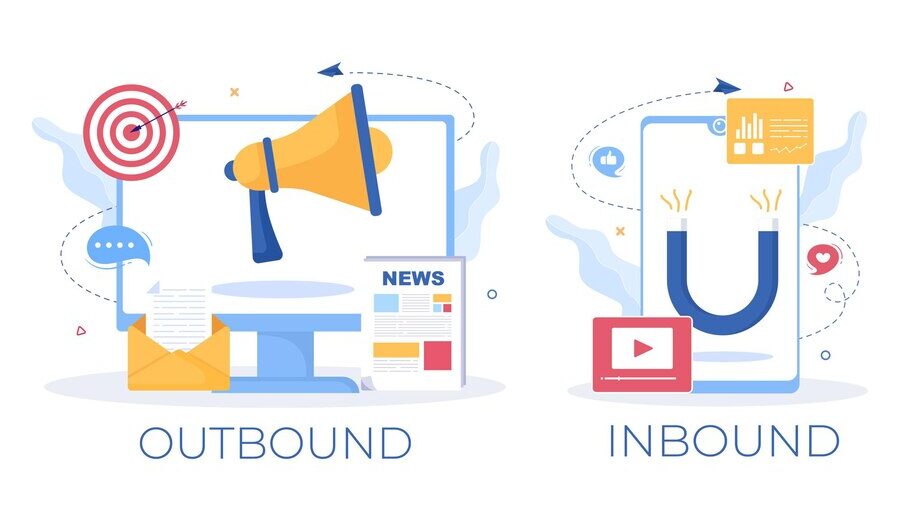Leads are the lifeblood of every B2B company. Leads must be converted into customers for the firm to be successful. As a marketer, you may contact potential clients and tell them about your company and its products. In the second situation, you build buzz around your brand in order to attract new buyers.
The former is known as outbound marketing, while the latter is known as inbound marketing.
What is the difference between inbound and outbound marketing?
There are some significant distinctions between inbound and outbound marketing. Outbound marketing entails proactively reaching out to consumers in order to pique their interest in a product. Inbound marketing, on the other hand, focuses on developing and sharing content that attracts visitors to your website.
Outbound marketing is often more aggressive and broad-reaching, with the assumption that at least some individuals would convert. Inbound marketing is generally more subtle and focused on gradually persuading a certain set of people to make a purchase.
Here are a few additional notable differences:
| Inbound Marketing | Outbound Marketing |
| Informative digital material aimed for specific audiences and designed to assist consumers in resolving difficulties. | Non-digital material intended to catch consumers’ attention and sell things. |
| Social media posts, blogs, reports, webinars, and other interactive types of content are available. | Content is shown passively via direct mail, magazine adverts, billboards, and on television, among other places. |
| Messaging is customised to individual customers. | Messaging must stand out amid the millions of other advertisements that customers encounter every day. |
| A comprehensive plan spanning various channels. | A linear method with a restricted number of channels. |
| Digital marketing software allows for measurement. | Physical advertising attribution is difficult to quantify. |
What exactly is inbound marketing?
The goal of inbound marketing is to attract people to your products and services. With up to 63% of consumers beginning their purchasing experience online, your greatest prospects are looking for things online.
They start by looking for items and services, or content, to meet a need or address an issue. As a result, your material should describe how your products or services will solve their problems, answer important questions in their sector, or meet their wants.
There are several ways to accomplish this, including:
Blogs
Video content
Guidebooks
Other online marketing content
Each of these bits of material may also be used to distinguish your product from the competitors. Incorporate product comparisons, incredible testimonials, competitive pricing, and stellar reviews into your podcast, social media postings, or reports.
Remember that prospective consumers should get intelligent information at various times along their purchasing journey that is varied in content but consistent in messaging.
The advantages of inbound marketing.
There are various advantages to inbound marketing that can help you decide if it is the best plan for your business:
- Inbound marketing is unobtrusive. Prospects may read your blog postings or participate in a webinar at their leisure.
- The content of inbound marketing is informative. It is customised for each level of the sales funnel.
- Inbound marketing may be measured. Each component of your approach may be linked to a measure that is tracked over time.
Because your website and content are always being updated, inbound marketing will continue to generate leads over time.
Inbound marketing’s challenges.
Inbound marketing isn’t right for every business. Several drawbacks to focusing only on digital material.
- Continuous upkeep is required.
- It takes a significant amount of time and work.
- A comprehensive plan is required.
What exactly is outbound marketing?
Outbound marketing involves sending a message to a large number of individuals in the goal of making a transaction. This method is based on the idea that the larger the group to whom you send a message, the greater the return.
Outbound marketing is frequently related with classic marketing methods such as:
Direct mail
Events
Billboards
Cold calling
Newspapers
Radio
TV
Outbound marketing, on the other hand, can be used to more current technologies, such as pay-per-click advertising and spam emails.
Consumers are frequently unaware of or uninterested in the promoted goods. Prospects may be watching TV or browsing a website when they are stopped by an advertisement demonstrating why they should purchase a specific product.
The advantages of outbound marketing.
Outbound marketing provides several advantages that should not be neglected.
- Increases brand recognition. Reach out to folks who have never heard of your products or services.
- Can produce quick results. People who are interested in your products and services are more likely to act on your advertisements and make a purchase.
- Is something that customers are accustomed to. They are aware that advertisements will appear in the Sunday paper or on television, and they may trust traditional advertisements more than those offered to them via modern technologies.
Outbound marketing’s challenges.
Outbound marketing may be challenging to master. Here are several drawbacks of taking this path:
- Outbound marketing is more broad.
- Consumers are prone to tuning out outbound marketing.
- Measuring efficacy is more difficult.
- Outbound marketing is expensive.
Conclusion
Inbound marketing vs outbound marketing? The truth is…neither is better for generating leads through marketing – you need both!
The key to better marketing
Inbound vs. outbound marketing? No matter your method, Mfinity’s data, and prospecting tools can power both. Our database is updated daily by our revolutionary AI and is 100% compliant with worldwide data regulations.
Make the most of your business by combining both marketing tactics. Mfinity believes in employing both outbound and inbound methods to assist you achieve your company objectives.


